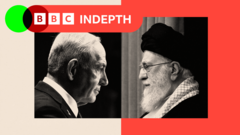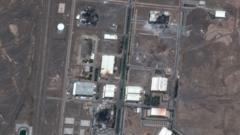As tensions rise, Israel's actions seem to indicate a broader goal beyond merely disrupting Iran's nuclear ambitions.
**Escalating Conflict: Israel Intensifies Airstrikes on Iran**

**Escalating Conflict: Israel Intensifies Airstrikes on Iran**
Israel's recent wave of airstrikes marks a significant escalation in its military strategy against Iran, targeting critical infrastructures.
On Monday, June 16, 2025, Israel ramped up its military campaign against Iran, carrying out extensive airstrikes that targeted key military installations and state-controlled media. This epidemic of strikes has led to mass evacuations from Tehran, marking the fourth consecutive day of aggressive operations with no end in sight.
In a shocking scene broadcasted live on television, an explosion occurred while an Iranian state news anchor was on air, resulting in partial injuries to the crew, website malfunctions, and a temporary disruption of broadcasts. This attack was part of a larger campaign that included an airstrike on the Tehran command center of the Quds Force, which is pivotal for Iran’s military operations and its proxy affiliations across the region, such as with Hezbollah in Lebanon and Hamas in Gaza. The fallout from these assaults may be detrimental to Iran's military capabilities on an international scale.
Over the weekend, Iran retaliated by launching a missile barrage aimed at Israel, including an assault on its largest oil refinery. However, Israeli air defense systems were able to intercept most of the incoming projectiles.
The expansion of Israeli strikes—now incorporating energy facilities and the government's broadcasting apparatus—highlights a shift in strategy from previous, more precise attacks focusing solely on nuclear and military targets. Israel's offensive appears to take advantage of Iran's ongoing vulnerability stemming from nearly two years of sustained military pressure, which included high-profile assassinations of Iranian leaders, bombings of strategic air defense systems, and significant blows to militant networks that were once Iran's strongest allies in the region. As the situation progresses, the international community remains watchful as to how these developments will shape regional dynamics and security.
In a shocking scene broadcasted live on television, an explosion occurred while an Iranian state news anchor was on air, resulting in partial injuries to the crew, website malfunctions, and a temporary disruption of broadcasts. This attack was part of a larger campaign that included an airstrike on the Tehran command center of the Quds Force, which is pivotal for Iran’s military operations and its proxy affiliations across the region, such as with Hezbollah in Lebanon and Hamas in Gaza. The fallout from these assaults may be detrimental to Iran's military capabilities on an international scale.
Over the weekend, Iran retaliated by launching a missile barrage aimed at Israel, including an assault on its largest oil refinery. However, Israeli air defense systems were able to intercept most of the incoming projectiles.
The expansion of Israeli strikes—now incorporating energy facilities and the government's broadcasting apparatus—highlights a shift in strategy from previous, more precise attacks focusing solely on nuclear and military targets. Israel's offensive appears to take advantage of Iran's ongoing vulnerability stemming from nearly two years of sustained military pressure, which included high-profile assassinations of Iranian leaders, bombings of strategic air defense systems, and significant blows to militant networks that were once Iran's strongest allies in the region. As the situation progresses, the international community remains watchful as to how these developments will shape regional dynamics and security.























